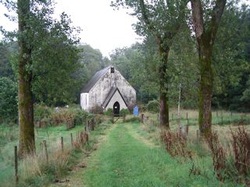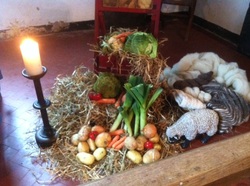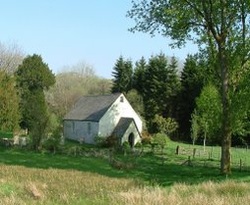St David's, Tirabad

Early History
There is evidence of Roman occupation in the area and there is a Roman road passing through the parish from Caerau, near Llangammarch to Llandovery which was the major road until the 19th
century when the present town of Llanwrtyd came into being and the road through the town became more important. There was a pre Norman parish of 3220 acres.
Legend tells that when Christianity first came to Wales an angel flew over the land with a bag of stones which were to be placed where churches would be built. As he flew over this desolate and remote place a stone accidentaly fell out of his bag and landed here, explaining why a church was
built in such an inaccessible place.
There is evidence of Roman occupation in the area and there is a Roman road passing through the parish from Caerau, near Llangammarch to Llandovery which was the major road until the 19th
century when the present town of Llanwrtyd came into being and the road through the town became more important. There was a pre Norman parish of 3220 acres.
Legend tells that when Christianity first came to Wales an angel flew over the land with a bag of stones which were to be placed where churches would be built. As he flew over this desolate and remote place a stone accidentaly fell out of his bag and landed here, explaining why a church was
built in such an inaccessible place.

Harvest at St David's, Tirabad
In 519 AD a Synod of the Church was held in Llandewi Brefi in Cardiganshire, at which St David was chosen to be the chief Bishop of Wales. St David came on a missionary journey down the valley of the River Irfon founding seven churches that lie on the south bank of the river including Llandewi Abergwesyn, Llandewi wrth y rhyd, (Llandewi by the ford ) i.e. Llanwrtyd, Llandewi in Tirabad, Llandewi Llwyn y Fynwent, Llandewi Llanynis, Llandewi Maesmynis and Llandewi'r Cwm.
In 1164 The Lord Rhys, Prince of Powys, gave to the monastery of Strata Florida in Ceredigion, Llandwrtyd, part of Llangammarch, Llandeilo'r Fan and the village now known as Tirabad. There
would have been a grange, possibly at the farm known as Llwyn Fynwent, where the name fynwent
-(cemetery) suggests that this could have been the site of the old Tirabad church. Other possibilities are Spite Inn, (Some think the name is possibly taken from Latin hospitium or Welsh ysbyty (hospital) which, sadly, was demolished by the military in 2008, or indeed the present site of the church which was known as 'The New Church' suggesting an earlier building here.
Probably during the Tudor period the earlier church became decayed and disused, though there must have been tremendous comings and goings in the parish in the heyday of the drovers, for Llandulas was the meeting place for those from Pembrokeshire, Carmarthenshire, Cardiganshire and Breconshire on their way to the great fairs of Barnet and Smithfield.
In 1536 the property passed to the Crown and was conveyed to Edward Wymark, later to become a Member of Parliament, and eventually the lands descended to Sir Sackville Gwynne of Glanbrân who built the present church in 1716.In 1820 the present porch was built,(now sadly removed for health and safety reasons!) the doorway in the north side of the building having been closed up at some time. The windows were restored by Lord St.David whose family built the Manor above the village before the First World War as a shooting lodge.
In 1164 The Lord Rhys, Prince of Powys, gave to the monastery of Strata Florida in Ceredigion, Llandwrtyd, part of Llangammarch, Llandeilo'r Fan and the village now known as Tirabad. There
would have been a grange, possibly at the farm known as Llwyn Fynwent, where the name fynwent
-(cemetery) suggests that this could have been the site of the old Tirabad church. Other possibilities are Spite Inn, (Some think the name is possibly taken from Latin hospitium or Welsh ysbyty (hospital) which, sadly, was demolished by the military in 2008, or indeed the present site of the church which was known as 'The New Church' suggesting an earlier building here.
Probably during the Tudor period the earlier church became decayed and disused, though there must have been tremendous comings and goings in the parish in the heyday of the drovers, for Llandulas was the meeting place for those from Pembrokeshire, Carmarthenshire, Cardiganshire and Breconshire on their way to the great fairs of Barnet and Smithfield.
In 1536 the property passed to the Crown and was conveyed to Edward Wymark, later to become a Member of Parliament, and eventually the lands descended to Sir Sackville Gwynne of Glanbrân who built the present church in 1716.In 1820 the present porch was built,(now sadly removed for health and safety reasons!) the doorway in the north side of the building having been closed up at some time. The windows were restored by Lord St.David whose family built the Manor above the village before the First World War as a shooting lodge.

Recent History
In 1838 there were 24 farms in the parish and the 1861 Census shows 130 people, but at the commencement of the Second World War the military took over the Eppynt as an artillery range
and the farms had to be vacated, with the result that the congregation of St David's dwindled to single figures and by the end of the war the church had fallen into disrepair.
There are harrowing accounts, reminiscent of the Highland Clearances, of the families who had lived on the Eppynt for generations having to leave their homes.See ' Eppynt Without People' available from Powys libraries.)
In about 1950 the Forestry Commission began plantations and built about 25 houses, a school, a village hall and a shop for their employees. Extensive repairs were subsequently made to the church and the graveyard was enlarged to provide for the needs of the new population.
In 1838 there were 24 farms in the parish and the 1861 Census shows 130 people, but at the commencement of the Second World War the military took over the Eppynt as an artillery range
and the farms had to be vacated, with the result that the congregation of St David's dwindled to single figures and by the end of the war the church had fallen into disrepair.
There are harrowing accounts, reminiscent of the Highland Clearances, of the families who had lived on the Eppynt for generations having to leave their homes.See ' Eppynt Without People' available from Powys libraries.)
In about 1950 the Forestry Commission began plantations and built about 25 houses, a school, a village hall and a shop for their employees. Extensive repairs were subsequently made to the church and the graveyard was enlarged to provide for the needs of the new population.